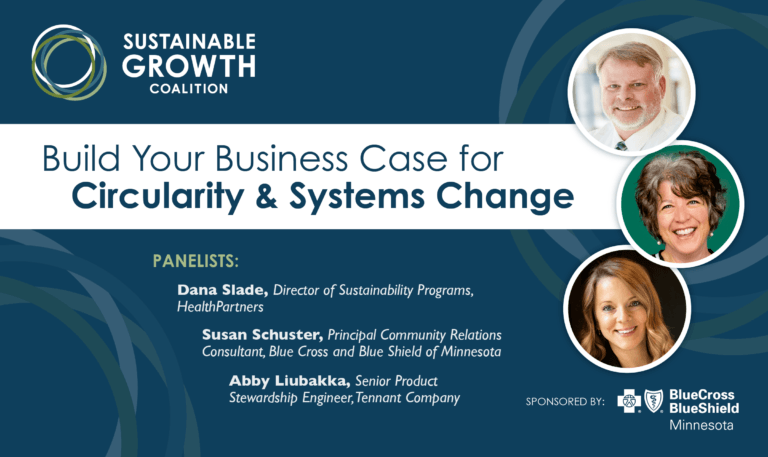The case for circularity highlighted in Sustainable Growth Coalition webinar

In a year where we have faced significant challenges, companies are responding by accelerating measures to address environmental and social issues. At the Sustainable Growth Coalition, our members are taking a systems approach to achieve sustainability goals, while addressing equity, climate change, and movement toward the circular economy.
The Sustainable Growth Coalition’s webinar, Build Your Business Case for Circularity and Systems Change, sponsored by Blue Cross and Blue Shield of Minnesota, showed how our members are leading, as well as sharing more case studies in our Circularity Toolkit. Keynote speakers included Sustainable Growth Coalition members: Dana Slade, Director of Sustainability Programs for HealthPartners; Susan Schuster, Principal Community Relations Consultant for Blue Cross and Blue Shield of Minnesota; and Abby Liubakka, Senior Product Stewardship Engineer for Tennant Company.
Each keynote speaker provided different circularity case studies that worked well within their organization’s strengths and structure, as well as tips for other organizations wishing to develop a more sustainable structure themselves. All our thoughtful speakers really focused on our Coalition’s shared mission–building the business case for sustainability and circularity.
Quotes and highlights from our fantastic webinar
“The RECON program enables us to maintain that high quality, while extending the useful life of our products, which by the way keeping products in use is one of the four pillars of the circular economy,” said Abby Liubakka on Tennant’s customer-focused RECON program, which has taken key steps in creating a more circular economy by refurbishing and reselling its previously owned products at a lower cost.
“The biggest thing that has given our sustainability programs success is partnerships,” stressed Dana Slade during his presentation on the importance of the sustainability business case. From partnering with Xcel Energy, to counties and utilities, as well as other member organizations, HealthPartners has worked to implement solar gardens that have produced over 12,600 MWh in solar energy to create more energy efficiency within their organization.
The Blue Cross and Blue Shield of Minnesota case study leveraged organizational assets to invest in the health of communities and reduce environmental inequity, by creating their Blue Cross Giving Garden initiative. “Envisioning a Minnesota with environmental equity for everyone…a circular economy is not possible without people, people are at the center, and if people are strong there is nothing we can’t do,” Susan Schuster shared, which I think really hits home on the relationship across systems and connection between circularity and equity. Additionally, Susan stressed that without addressing and changing systemic problems, change will be unlikely, and all stakeholders must work together to address these systemic problems, and I completely agree. It’s why collaboration, building relationships, and sharing ideas across sectors is key to our work at the Coalition.
The webinar included a Q&A at the end, in which all our speakers noted the significance of innovation and remaining open to new ideas when it comes to implementing new sustainability methods and systems change. Whether your organization provides a product, service, or something else, sustainability measures can be taken to work toward creating a more circular economy. Learn how your business and organization can build the business case for circularity in the Sustainable Growth Coalition’s Circularity Toolkit.